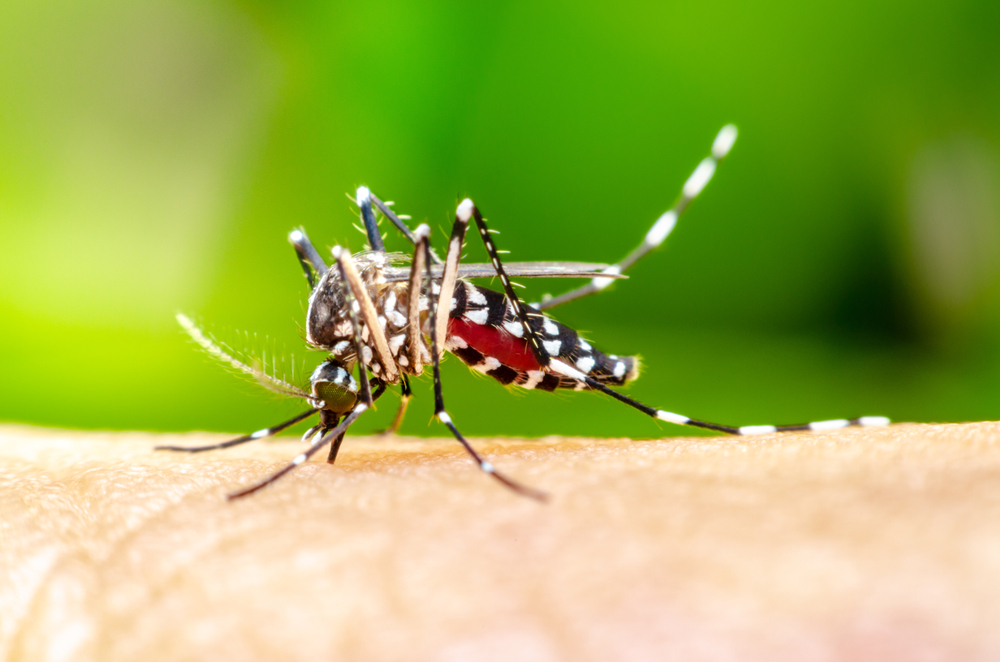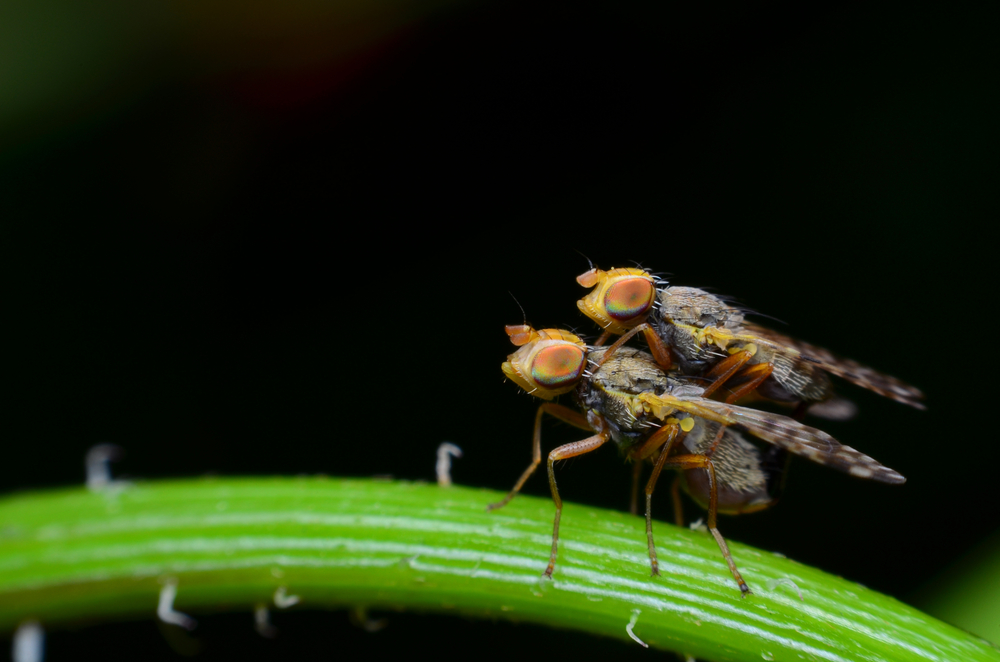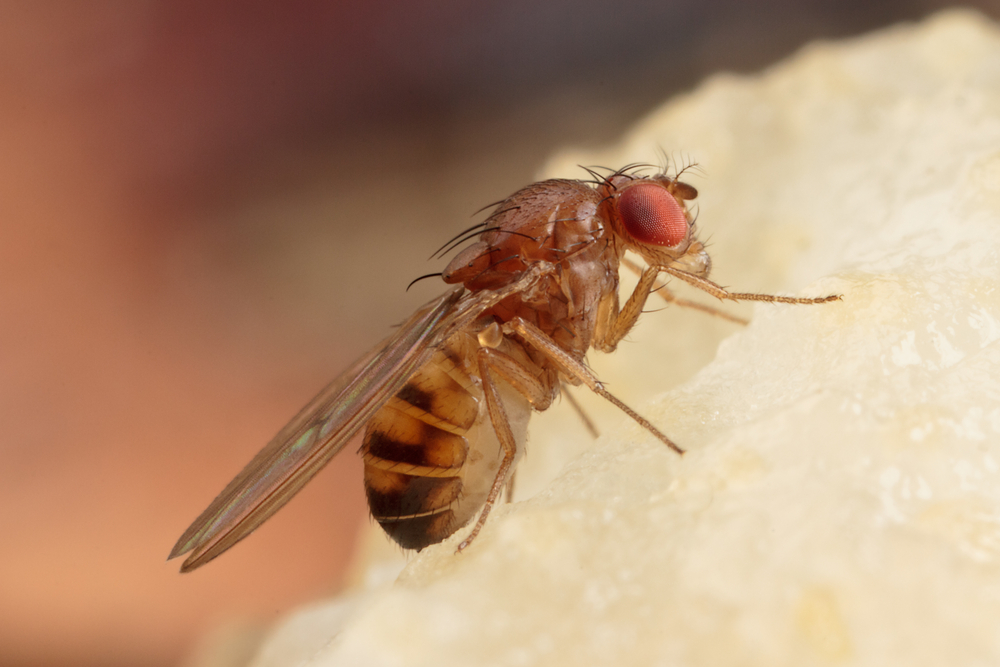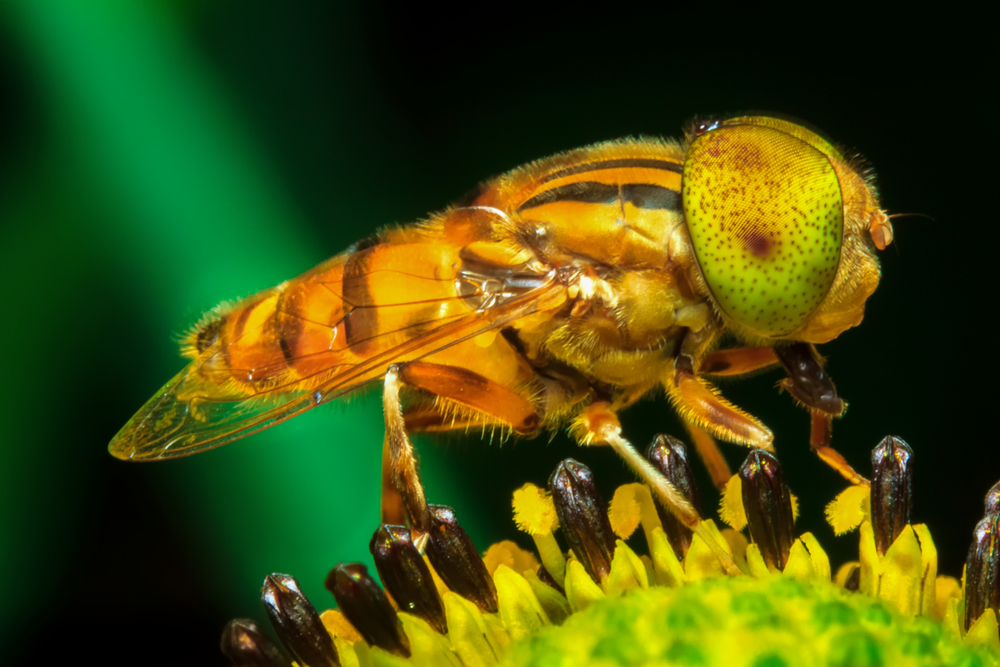About
The Fruit Fly, scientifically known as Drosophila melanogaster, is a species of small fly within the Animal Kingdom’s phylum Arthropoda and class Insecta. It belongs to the Drosophilidae family, which includes thousands of species of fruit flies. While Drosophila melanogaster is widely studied in genetics and developmental biology, it is just one of many fruit fly species.
Fruit flies are characterized by their small size, typically measuring around 2 to 4 millimeters in length, and their red eyes. They are often found near ripe or fermenting fruits and vegetables, where they feed and lay their eggs. Fruit flies have a short lifespan, with adults living for only a few weeks.
These insects are prolific breeders, with females capable of laying hundreds of eggs in their lifetime. The eggs hatch into larvae, commonly known as maggots, which feed on the fermenting fruit before pupating and emerging as adults. Fruit flies play a crucial role in ecosystems by helping to break down organic matter and aiding in the process of decomposition.
While fruit flies are not typically considered threats to human health, they can be a nuisance in homes, grocery stores, and agricultural settings. Fruit fly infestations can lead to food spoilage and economic losses in the agriculture industry.
Conservation Concerns
Fruit flies are not assessed for conservation status on the International Union for Conservation of Nature (IUCN) Red List due to their abundance and wide distribution. However, certain fruit fly species may face threats from habitat loss, pesticide use, and climate change.
In agricultural settings, fruit fly infestations can lead to crop damage and reduced yields, posing challenges for farmers and food security. Integrated pest management strategies, including cultural, biological, and chemical control methods, are commonly used to manage fruit fly populations and minimize their impact on crops.
Public education and awareness about proper sanitation practices and preventive measures, such as storing fruits and vegetables in sealed containers, can also help reduce fruit fly infestations. Continued research into fruit fly biology, behavior, and control methods is essential for developing effective strategies to manage these insects and mitigate their impact on agriculture and ecosystems.
Physical Characteristics
The Fruit Fly, particularly the species Drosophila melanogaster, is a small, winged insect extensively studied in genetic research due to its simple genetic makeup and rapid life cycle. Native to Africa, this tiny fly has spread worldwide and is commonly found in various environments, especially those where ripe or fermenting fruit is present.
Size and Weight:
- Length: Fruit flies measure approximately 0.1 to 0.15 inches (2.5 to 4 millimeters) in length.
- Weight: Due to their minuscule size, the weight of a fruit fly is less than 1 milligram (0.001 grams) and not commonly specified in scientific measurements.
Physical Characteristics:
- Body Color: Drosophila melanogaster typically has a yellow-brown body with black stripes on the abdomen, making them easily identifiable under a microscope or magnifying glass. The color can vary slightly depending on the specific genetics of the population.
- Eyes: One of the most distinctive features of the fruit fly is its large, red eyes, although eye color can vary due to genetic mutations. These compound eyes are made up of many tiny lenses, allowing them to detect movement and navigate efficiently.
- Wings: They have a single pair of clear wings that are longer than their body. The wings allow for quick, agile flight, which is essential for escaping predators and finding food. The wing pattern and vein structure are often used in genetic studies.
- Legs: Fruit flies have six legs, with the hind pair being longer than the others. Their legs are equipped with tiny hairs and pads that allow them to walk on smooth surfaces and adhere to various substrates.
- Antennae: Their antennae are short and feathered, playing a crucial role in detecting odors and navigating toward food sources or potential mates.
- Mouthparts: Fruit flies have sponge-like mouthparts designed for feeding on liquid or semi-liquid substances. They are particularly attracted to the sugars in ripe or fermenting fruit, from which they derive both nutrients and moisture.
- Reproductive Organs: The female’s ovipositor, used for laying eggs, is slightly protruding and can be seen under magnification. The reproductive system of fruit flies is a key area of study in genetics and developmental biology.
The Fruit Fly’s small size, rapid reproduction rate, and genetic simplicity have made it an invaluable model organism in scientific research, contributing significantly to our understanding of genetic inheritance, development, and disease. Despite their common presence in homes and gardens, fruit flies’ contribution to science is immense, underscoring the importance of even the smallest creatures in the vast web of life.
Reproduction
The reproductive cycle of fruit flies, like that of many insects, is characterized by rapid development and high reproductive output. Here’s an overview:
Mating Behavior: Fruit flies, particularly Drosophila melanogaster, are known for their elaborate courtship rituals. Males perform a series of courtship displays, including wing vibrations and pheromone release, to attract females. Once a mating pair is formed, copulation occurs quickly.
Egg Laying: After mating, the female fruit fly searches for suitable egg-laying sites, typically on decaying fruit or other organic matter. Using her ovipositor, she deposits small batches of eggs near food sources to provide nourishment for the emerging larvae.
Egg Development: Fruit fly eggs hatch quickly, typically within 24 to 30 hours after being laid. The larvae, or maggots, emerge and begin feeding voraciously on the surrounding food source. The larvae go through several molts as they grow, shedding their exoskeletons to accommodate their increasing size.
Pupation: Once the larvae have completed their feeding stage, they enter the pupal stage, where they undergo metamorphosis into adult flies. Pupation occurs in a protective casing, known as a puparium, which forms from the hardened larval skin.
Adult Emergence: After a few days to weeks, depending on environmental conditions, adult fruit flies emerge from their pupal cases. The newly emerged adults are soft and pale initially but quickly darken and harden as they mature.
Reproductive Maturity: Fruit flies reach sexual maturity shortly after emerging from the pupal stage. They are capable of mating and reproducing within a few hours of becoming adults.
Reproductive Output: Fruit flies are prolific breeders, with females capable of laying hundreds of eggs in their lifetime. Under optimal conditions, the entire life cycle from egg to adult can be completed in as little as 7 to 10 days, allowing for rapid population growth.
Environmental Factors: The reproductive cycle of fruit flies is highly influenced by environmental factors such as temperature, humidity, and food availability. Warm temperatures and abundant food sources can accelerate development and increase reproductive output, while unfavorable conditions may slow down or halt reproduction.
Adaptations and Survival: The rapid reproductive cycle of fruit flies is an adaptation that allows them to exploit ephemeral food sources and colonize new habitats quickly. Their ability to reproduce rapidly contributes to their success as a model organism in scientific research and makes them a significant pest in agriculture and food storage.
Lifespan
Fruit flies, scientifically known as Drosophila melanogaster, are small insects belonging to the family Drosophilidae. They are widely studied in scientific research due to their short lifespan, rapid reproduction, and genetic similarities to humans. Here’s an overview of their lifespan and threats to their life:
Lifespan in the Wild: In their natural habitat, fruit flies have a relatively short lifespan, typically living for about 30 to 40 days. Their life cycle includes four stages: egg, larva, pupa, and adult. Environmental factors such as temperature, humidity, and food availability can influence their lifespan in the wild.
Lifespan in Captivity: In laboratory settings, where environmental conditions are controlled and food is abundant, fruit flies can live slightly longer than their wild counterparts. Under optimal conditions, they may live for up to 60 days or more in captivity. However, their lifespan in captivity can vary depending on genetic factors, diet, and laboratory protocols.
Threats to Fruit Flies:
- Predation: Fruit flies are preyed upon by various predators, including spiders, birds, reptiles, and other insects. Predation pressure can affect their population dynamics and survival rates, especially in natural environments where they are exposed to multiple predators.
- Habitat Loss: Destruction and fragmentation of natural habitats, such as forests, grasslands, and agricultural areas, can impact fruit fly populations by reducing their available habitat and food resources. Loss of suitable breeding sites and foraging grounds can lead to population decline and local extinctions.
- Pesticides: Fruit flies are often considered pests in agricultural settings due to their ability to infest fruits and vegetables, causing economic losses to farmers. Insecticides and pesticides used to control fruit fly populations can also harm non-target species, disrupt ecosystems, and pose risks to human health and the environment.
- Competition: Competition for food and breeding sites with other insect species can affect fruit fly populations, especially in areas where resources are limited or highly sought after. Interspecific competition may influence their distribution, behavior, and reproductive success in natural habitats.
- Climate Change: Climate change can impact fruit fly populations by altering temperature regimes, precipitation patterns, and seasonal cycles. Shifts in climatic conditions may affect their developmental rates, reproductive behavior, and geographic distribution, leading to changes in population dynamics and community interactions.
Understanding the factors that affect fruit fly populations is essential for pest management strategies, conservation efforts, and ecological research. Conservation measures may include habitat restoration, integrated pest management practices, and sustainable agricultural practices to minimize negative impacts on fruit fly populations and their ecosystems.
Eating Habits
Fruit flies, scientifically known as Drosophila melanogaster, are small insects belonging to the family Drosophilidae. They are commonly found near decaying fruits and vegetables and play a crucial role in ecological processes such as decomposition and nutrient cycling.
Diet: Fruit flies are primarily attracted to and feed on:
- Decaying Organic Matter: Fruit flies are attracted to fermenting fruits, vegetables, and other organic matter undergoing decomposition. They feed on the microorganisms present in the decaying material, including yeasts and bacteria.
- Microbial Growth: Fruit flies consume the microorganisms that proliferate on decaying organic matter. These microorganisms serve as a primary food source for fruit flies and provide essential nutrients necessary for their growth and reproduction.
Feeding Behavior: Fruit flies exhibit specific feeding behaviors to access and consume their food sources:
- Probing and Sponging: Fruit flies use their specialized mouthparts to probe and sponge up liquids from decaying fruits and other organic matter. They have sponge-like mouthparts called labellum, which they use to soak up liquids, facilitating feeding on liquid substances.
- Extracellular Digestion: Fruit flies rely on enzymes produced by their salivary glands to break down complex organic molecules present in decaying matter into simpler compounds that they can absorb and utilize for nutrition.
Life Cycle and Feeding Preferences:
- Fruit flies undergo complete metamorphosis, consisting of egg, larval, pupal, and adult stages. While adult fruit flies primarily feed on liquids, larvae, commonly known as maggots, consume solid organic matter during their development.
- The preference for decaying fruits and vegetables makes fruit flies significant pests in agriculture and food storage facilities. They can infest and damage a wide range of fruits and vegetables, causing economic losses and food spoilage.
- Fruit flies are attracted to the scent of ripe or fermenting fruits, which releases volatile compounds that signal potential food sources. They are also drawn to the microbial communities present on decaying matter, which provide suitable habitats for feeding and reproduction.
Impact on Human Health:
- While fruit flies are not known to transmit diseases to humans directly, they can serve as vectors for pathogenic microorganisms. Their association with unsanitary conditions and decaying organic matter can pose hygiene risks in food preparation areas and storage facilities.
- Fruit flies are commonly used as model organisms in scientific research due to their short lifespan, rapid reproductive rate, and well-characterized genetics. Their simple nervous system and genetic tractability make them valuable tools for studying various biological processes and human diseases.
Uniqueness
The Fruit Fly, particularly the species Drosophila melanogaster, is an exceptionally important model organism in scientific research, offering unique insights into genetic and developmental processes. Here’s what makes the Fruit Fly unique:
Genetic Simplicity and Versatility: Fruit flies have a relatively simple genetic makeup, with about 14,000 genes on four chromosomes, making them easier to study than more complex organisms. They share many genes with humans, making them an excellent model for understanding human genetics and diseases.
Rapid Life Cycle: One of the most beneficial features of fruit flies is their short life cycle, which is about 10 days from egg to adult under optimal conditions. This allows for multiple generations to be studied over a short period, facilitating genetic and developmental research.
Low Maintenance: They require minimal space and resources to breed and maintain in laboratory settings. This cost-effectiveness makes them accessible for various types of genetic, neurological, and behavioral studies.
High Fecundity: Female fruit flies are highly fecund, capable of laying hundreds of eggs during their lifetime. This prolific reproduction allows for large-scale studies and statistical analysis of genetic traits across many specimens.
Well-Documented Genetic History: Decades of research have led to a comprehensive understanding of fruit fly genetics, with detailed gene maps and a fully sequenced genome available. This extensive documentation aids researchers in pinpointing specific genes and their functions.
Tool for Genetic Engineering: Fruit flies are ideal for genetic manipulation, enabling scientists to explore gene function and interaction. Techniques such as transposon mutagenesis, RNA interference, and CRISPR have been effectively applied in fruit flies to study gene expression and regulation.
Behavioral Studies: Beyond genetics, fruit flies are used to study behavior and neuroscience. They exhibit a range of behaviors from courtship to learning and memory, which can be genetically and chemically manipulated, providing insights into neurological disorders.
Disease Models: They are used as models for a number of human diseases, including Parkinson’s, Alzheimer’s, and cancer. Research involving fruit flies has led to breakthroughs in understanding disease mechanisms and testing potential treatments.
Conservation and Environmental Studies: While not a major focus, fruit flies also serve in studies related to ecosystem dynamics and conservation, particularly in understanding how species adapt to changing environments.
The unique combination of genetic simplicity, rapid lifecycle, and ease of maintenance makes the Fruit Fly an indispensable tool in biological and medical research, providing insights that are crucial for advancing knowledge in genetics, development, and beyond.
Sources
- Britannica, Fruit Fly, https://www.britannica.com/animal/fruit-fly, Retrieved March 2024
- Burnie, David & Wilson, Don, Animal, Smithsonian Institute, Washington DC.
- Hickman et al, Integrated Principle of Zoology, McGraw Hill, Boston.





































































